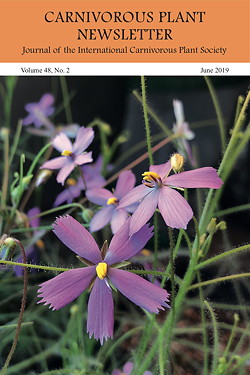International Carnivorous Plant Society
Carnivorous Plant Newsletter Archive
Nocturnal and diurnal digestive responses in Byblis gigantea, Drosophyllum lusitanicum, and Roridula gorgonias
Gregory Allan
Carniv. Pl. Newslett. 48(2):64-73
Published 9 May 2019
https://doi.org/10.55360/cpn482.ga994
Summary
Byblis Salisb. is a highly understudied carnivorous genus currently consisting of eight recognized species – now with motile adhesive traps (Allan 2019 [p 51 this issue])). In particular, the carnivorous syndrome exhibited by the genus is imperfectly understood when compared to other carnivorous plant genera. The leaves, stems, pedicels, and sepals bear stalked glands and digestive glands. The stalked glands vary in length, even within individual plants, the longest stalks reaching 2.6 mm in length (McPherson 2010). Each stalked gland bears a droplet of mucilage, assumed to be sugar-based and water-soluble (Bauer et al. 2018), that is responsible for prey-capture. The far more numerous digestive glands sit in rows in longitudinal grooves on the epidermis (Lloyd 1942) (see Fig. 1) and are usually assumed to secrete digestive fluids in response to prey-capture, as well as to absorb the products of digestion (Cross et al. 2018). The stalked glands are capable of collapsing in response to detection of animal proteins, apparently due to a rapid loss of cell turgidity. In consequence, prey can be brought within the range of the secretions of the digestive glands.
Keywords: Nocturnal, diurnal, digestive responses, Byblis gigantea, Drosophyllum lusitanicum, Roridula gorgonias
Article Citation
Gregory Allan. 2019. Nocturnal and diurnal digestive responses in Byblis gigantea, Drosophyllum lusitanicum, and Roridula gorgonias. Carniv. Pl. Newslett. 48(2):64-73. https://doi.org/10.55360/cpn482.ga994
Page views: 1131
©2025 International Carnivorous Plant Society
www.carnivorousplants.org
This page is maintained by John Brittnacher.
Please contact us at our membership website, icps.clubexpress.com.
Privacy: The Carnivorous Plant Newsletter Archive website does not track users.

